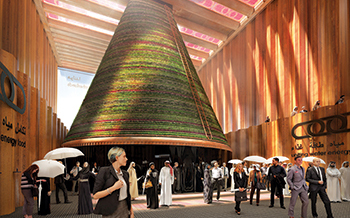US, Netherlands unveil Expo pavilion models
01 January 2019
The US has unveiled the architectural model of its Expo 2020 pavilion, which is being designed by renowned Colorado-based Curtis W Fentress of Fentress Architects.
The Pavilion USA 2020, a public-private partnership between the US Department of State and a private sector consortium of leading US entities, will showcase the very best of the country’s cultural and commercial achievements.
The architectural model of the US Expo 2020 pavilion was unveiled at a colourful ceremony held in Dubai. The model has been designed to project a sensation of movement.
Unveiling the model, Fentress said: “We have designed this building to be circular in form with slants fashioned to project a sensation of movement, making the viewer feel like the building itself is in motion. And then, once you enter the building, it opens up to what the US stands for: We are an open, accessible country where you can live to create ideas. It showcases all the things we are doing in America: developing technology and concepts that are going to move us forward in the future.”
Designing this pavilion is a tremendous responsibility – one we take very seriously – as we will be showcasing America and American ideas to over 25 million people expected to visit the Expo,” he adds.
Meanwhile, a consortium, comprising Expomobilia, V8 Architects, Kossmann.dejong and Witteveen+Bos, has won the contract to design the Netherlands country pavilion for the mega Expo 2020 gala event.
The Netherlands will be represented by a standout pavilion that is not a building in the traditional sense, but a temporary climate system built using locally sourced materials. The 3,727-sq-m Dutch pavilion has been designed as a closed-loop climate system in which private and business visitors will enjoy an intense sensorial experience.
The pavilion is the embodiment of the Netherlands’ chosen theme of ‘uniting water, energy, food’ and demonstrates the connection this country is so good at making between sustainable energy, water management, agriculture and circularity, said a spokesman for the Ministry of Foreign Affairs, the Netherlands Enterprise Agency while unveiling the winning design.
Inside the pavilion, visitors will be treated to a sensorially rich experience of Dutch know-how and skills in the field of innovative water, energy and food harvesting, he stated.
The circular or closed-loop climate concept generates a world in which visitors are able to immerse themselves in silence, warmth, coolness, light, darkness, agriculture and water, and in which they can discover natural ways of controlling climate. In Dubai’s dry desert climate, the Netherlands will create a temporary biotope, he added.
To minimise transport, the entire pavilion will be constructed with locally sourced construction materials.
All materials will be either given back or recycled after the expo closes, a strategy that will keep the pavilion’s ecological footprint as small as possible.
- Meydan One on track for early 2020 launch
- Tonino Lamborghini Residences unveiled
- Acwa inks Noor Energy 1 Plant deal
- $1.05bn projects launched in Al Dhafra
- Arada awards deals for 800 Sharjah homes
- Abu Dhabi sets up new water, electricity company
- US, Netherlands unveil Expo pavilion models
- Borouge breaks ground on fifth polypropylene unit
- Facade work to begin on RIU resort in Dubai
- Qasr Al Hosn site opens after revamp
- Dubai crowned district cooling ‘Champion City’
- New Abu Dhabi road opened



